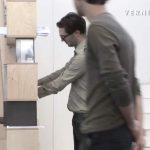In this video, we have a look at the work of Jasper Niens, an artist who is known for his site-specific installations for art fairs. Each of the installations deal with the traditional booth architecture that art fairs are known for and transforms it. For Art Basel Miami Beach he conceived an installation that doesn’t quite fulfill the expectations of the regular art collector. Rather than providing easy access to the gallery’s commodities, Jasper Niens designed a space that can only be entered by squeezing through a narrow corridor. VernissageTV met with Jasper Niens at the booth of Galerie West. In the conversation with Sabine Trieloff, Niens talks about his new installation, titled 35-II, and his work in general.
We first saw an installation by Jasper Niens when we worked on our coverage of Art Forum Berlin 2009 in collaboration with Art – Das Kunstmagazin. Until now, Jasper Niens realized four installations that deal with art fair architecture: 6 Doors (Preview Berlin, 2008); Handicap Principle II (Art Forum Berlin, 2009); 5 Rooms (NADA Miami Beach, 2009); 35-II (Art Basel Miami Beach, 2010).
Jasper Niens: 35-II, site-specific installation at Art Basel Miami Beach, Galerie West. Interview with Jasper Niens, December 4, 2010.
> Right-click (Mac: ctrl-click) this link to download Quicktime video file.
From the press release:
After the success at NADA 2009 with his installation 5 rooms, Jasper Niens (1980) is presenting a new installation at the fair, specially made for Art Basel Miami 2010. The architectural objects of Niens create spaces that seem without function at a first glance. Physical obstacles such as narrow corridors or locked doors increase this feeling but are at the same time the core of his work. Fascinated by conventions and the human (group) behavior, Niens searches for limits with his work and confronts the audience with his idea about privacy, determination and solidarity. He constructs interventions, mostly made of wood or metal, which change their meaning of space both inside a building and in open air. Terms such as isolation, quest or transitions are not only topics for Niens, but can be experienced physically in his work as soon as we move inside his work. The installation he has made for Art Basel Miami Beach is strongly related to the architecture of the fairground and is directed at the audience in an unexpected imperative manner.
Niens’ installations have been exhibited at NADA 2009, Miami Beach; Gemeentemuseum, Den Haag; Tent, Rotterdam; Site-ations, Zaragoza; Art Zuid, Amsterdam; and West, Den Haag, amongst other places.




